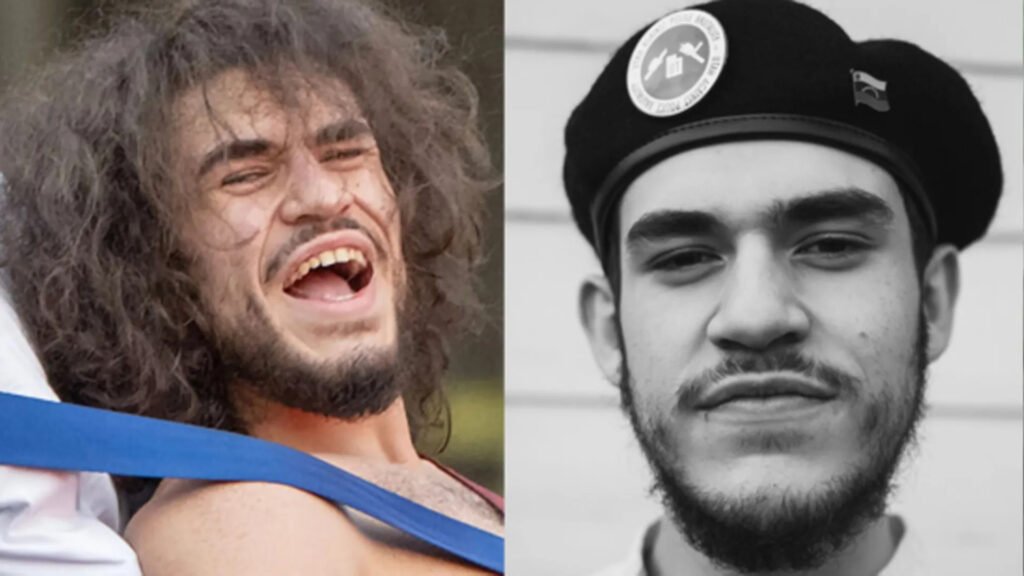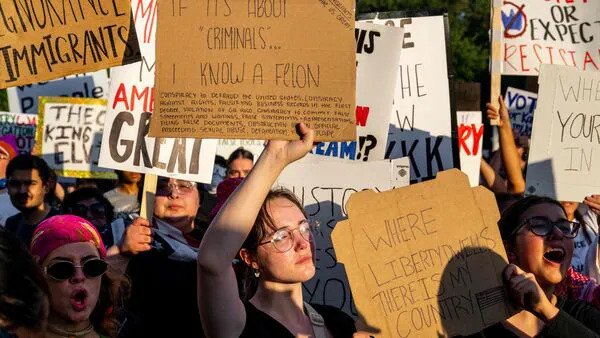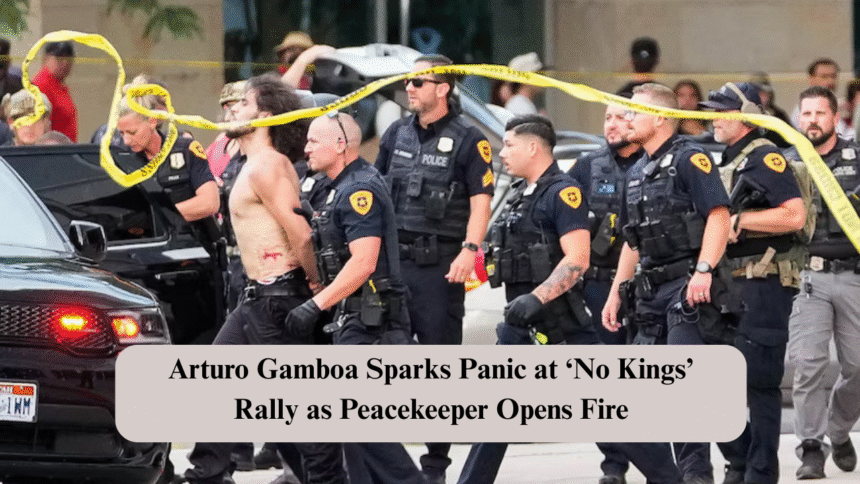Arturo Gamboa sparked widespread panic at the “No Kings” rally this weekend when he was seen carrying what appeared to be a rifle through the crowded protest. The event, which had begun peacefully with chants against monarchial systems and oppressive structures, turned chaotic in seconds as a member of a civilian peacekeeping group opened fire in response to the perceived threat. A bystander, described as an innocent attendee, tragically lost their life in the exchange.
The presence of Arturo Gamboa at the rally has raised serious questions about security, armed attendees, and the role of self-appointed peacekeepers in public demonstrations. The moments that led to the tragedy are still under active investigation by local authorities. However, video footage and eyewitness accounts offer a chilling narrative of fear, confusion, and miscalculation.
Rising Tension: Arturo Gamboa Enters the Scene
Witnesses first reported seeing Arturo Gamboa approaching the crowd around mid-afternoon. He wore a black backpack, a red bandana over his face, and what appeared to be tactical gear. According to those nearby, he made no direct threats and did not brandish his weapon in a hostile manner. Nonetheless, the visible presence of a rifle sent waves of concern throughout the protest.

Multiple attendees alerted the peacekeeper group responsible for crowd monitoring. These volunteers, separate from law enforcement and largely untrained, were carrying their own firearms under the claim of protecting demonstrators from external threats. When one of them confronted Gamboa, what was intended as a precautionary measure escalated into violence.
The Fatal Moment: Peacekeeper Fires on Arturo Gamboa
According to video evidence, the confrontation lasted mere seconds. A male peacekeeper shouted commands at Gamboa to lower his weapon. Gamboa, who appeared startled, turned his body as if to respond. That movement, whether defensive or reflexive, was interpreted as a threat. The peacekeeper fired several rounds, one of which struck a bystander who was standing behind Gamboa.
The victim was quickly attended to by other protestors, some of whom had basic medical training. Emergency services arrived shortly thereafter, but the victim was pronounced dead at the scene. Arturo Gamboa, who was unharmed during the exchange, was immediately detained by law enforcement officers arriving in response to the gunfire.
Who Is Arturo Gamboa?
Arturo Gamboa is a 31-year-old resident of the Salt Lake area, previously unknown to both protest organizers and law enforcement. Initial reports suggest that Gamboa is not affiliated with any political or extremist group. Neighbors and coworkers described him as quiet, intelligent, and politically disengaged.
Authorities are currently exploring Gamboa’s motivations for attending the rally armed. Early interviews suggest he may have been attending the protest as an observer or, possibly, with intentions to document it. His reason for carrying a weapon remains unclear. Legal experts argue that although Utah law allows open carry of firearms, bringing one into a volatile public gathering is deeply irresponsible.
Aftermath and Community Reaction
The death of the innocent bystander has enraged the community. What began as a protest against systemic power became the setting for a preventable tragedy. Many are calling for tighter restrictions on firearms at public demonstrations and demanding better training — or disbanding — of unofficial peacekeeper groups.

Arturo Gamboa’s name quickly trended across social media platforms, sparking a wave of criticism, speculation, and misinformation. His image, pulled from surveillance and protest footage, circulated online, fueling outrage. Civil rights groups have called for calm, urging the public to wait for a thorough investigation before passing judgment.
Meanwhile, the peacekeeper who fired the fatal shot has been placed under custody pending further inquiry. While he claimed he believed Arturo Gamboa posed an immediate danger to the crowd, many protestors insist that the situation did not require deadly force.
Legal and Political Fallout
The incident has led to renewed debates over the presence of armed civilians at protests. Critics argue that Arturo Gamboa’s actions, though possibly legal under state law, were reckless and inflammatory. Others say the peacekeeper, not Gamboa, should bear full responsibility for using force without proper cause or training.
Political leaders are now facing increased pressure to regulate both firearms at public gatherings and the informal “peacekeeping” groups that operate alongside protesters. Utah lawmakers are split: some defend the right to bear arms under the Second Amendment, while others see this as a moment to reexamine how guns intersect with public safety.
Civil rights attorneys have also raised concerns that incidents like these are being used to justify stricter protest regulations. They argue that blaming Arturo Gamboa alone obscures systemic issues, such as the normalization of vigilantism and the absence of clear guidelines for protest security.
You may also like: Nezza Sparks Controversy at Dodgers Game with Spanish Rendition of National Anthem
Arturo Gamboa Under Scrutiny
As the investigation continues, Arturo Gamboa remains a key figure in the tragedy. Though he did not fire a single shot, his presence with a visible weapon at a highly charged protest environment is under deep scrutiny. Whether his intent was peaceful or not, the outcome has left a scar on the community.
This is the third major protest-related incident in the last six months where the presence of armed individuals has led to deadly outcomes. Arturo Gamboa’s case is now part of a larger national conversation about protest safety, the role of civilians in policing demonstrations, and the dangerous combination of fear and firearms.
Moving Forward
As Salt Lake City mourns the loss of an innocent protester, activists are demanding justice and change. Arturo Gamboa, though not directly responsible for the fatal shot, remains symbolic of the broader issue at hand — the unpredictable and often deadly consequences of guns at public protests.
Public forums, legal debates, and activist gatherings continue to address the consequences of that fateful moment. Organizers of the “No Kings” rally have pledged to return to the streets, this time with stricter guidelines and more collaboration with licensed security professionals.
The memory of the lost bystander will serve as a painful reminder of the risks facing those who gather to speak truth to power. Whether Arturo Gamboa’s presence was naïve, calculated, or misunderstood, the outcome has ignited a national discussion that won’t fade soon.

